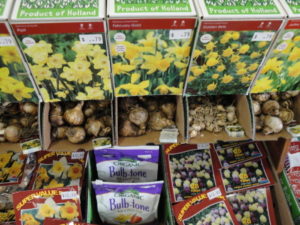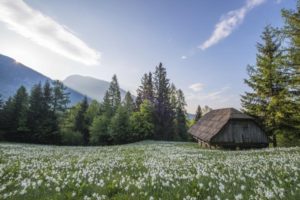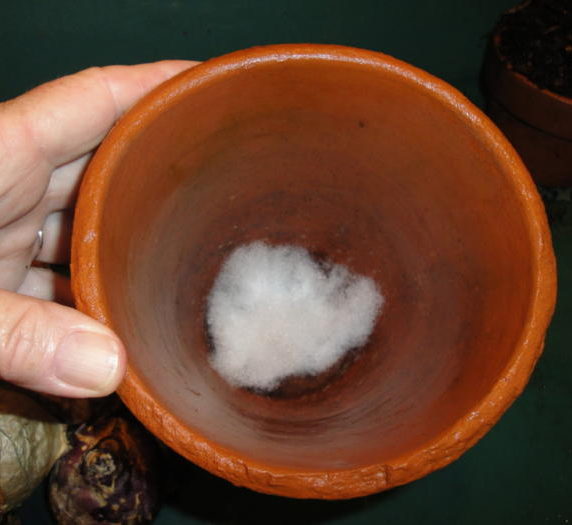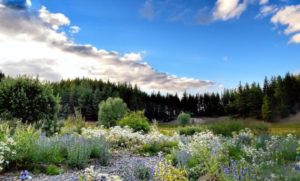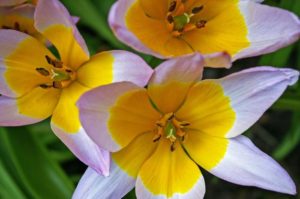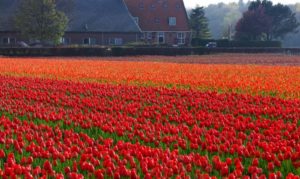Page 5
Maintenance
Use a light application of bulb fertilizer in autumn, when emerging roots can absorb it. If you’ve been fertilizing flower beds where the bulbs will be added, you can probably skip the fall application.Water the bed if the soil is dry.
There’s no need to protect bulbs when it snows; however, covering them during severe ice storms will prevent damage.
In spring, around peak bloom, reapply fertilizer, providing nutrients to a mature leafy plant. Bone meal is okay, but I prefer balanced fertilizers that provide more nutrients. Look for products specifically formulated for bulbs. If you’re amending the soil, don’t use manure near the bulbs.
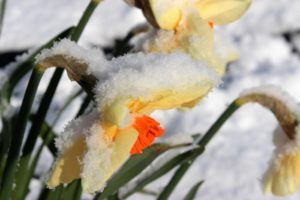
Many gardeners braid daffodil leaves to tidy up the garden. Granted, the maturing foliage can look a little unkempt. But the practice of tying up the leaves into a light-excluding daffodil “bun” doesn’t allow the foliage to adequately photosynthesize. The fleeting few weeks that the plants are in leaf is the only time they’re able to absorb enough of the sun’s energy to see them through a long dormancy.
Garden experts recommend letting the plants stay in leaf for only 6 to 8 weeks, and then cutting off all foliage. I prefer to wait until the leaves are at least half-yellow, so the bulbs can absorb the maximum amount of carbohydrate generated by photosynthesis. This is how you’ll see the most flowers the following year.
Tricks To Hide Maturing Foliage
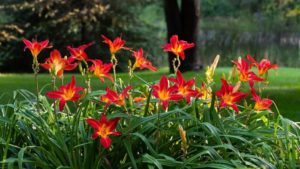
A clump of daylilies.
- Plant perennials in front of or around the bulbs. Examples: Heuchera ‘Citronelle’ (needs light shade when weather warms up) behind Eranthis; herbaceous Phlox paniculata in front of bulbs.
- Plant bulbs among groups of perennials that have a similar habit. Examples: daylilies (Hemerocallis, photo, above) over daffodils; Liriope ‘Royal Purple’ over Dutch Crocus or Narcissus ‘Tête-à-Tête’; low-growing Veronica varieties over Puschkinia, Scilla, and other minor bulbs.
- Plant cool-season biennials, such as pansies and violas, in the fall. They’ll be well established when bulbs come up. Gently push the foliage down into the pansies when it begins to lean over, but not where it’s too shady. Plant pansies in the spring if your winter climate is too cold for them. Use colors that complement the bulbs’ flowers in this classic combination. Plant a wider bed of pansies and violas in front of the bulbs, so the flowers become the dominant focus as the bulbs finish blooming. Pansies will continue to flower until warm weather arrives, in late spring or early summer.
- Snapdragons, diascia, dusty miller, and dianthus are more cool-tolerant plants that can be used.
- Plant bulbs between groups of shrubs. As the bulb foliage declines, nudge it under or behind the shrubs, but not where it’s too shady.
- Plant bulbs behind evergreen ground covers, such as Vinca minor (periwinkle), Iberis (candytuft), Pachysandra, and creeping Junipers.
- As the bulbs’ leaves turn yellow at the tips, you can cut the leaves in half, allowing the remaining green parts to continue to photosynthesize. The rest will wither without being noticed.
The Final Cut
Once the leaves have withered or turned mostly yellow, clip the leaves at ground level. Pulling them off could damage the top of the bulbs before the leaves have had a chance to naturally separate. This is optional. In wild parts of the garden, let the old foliage disintegrate into the soil.
Stinzenplanten
Many of the bulbs we use in our gardens are native to the Caucasus mountains, from southern Russia to Turkey, to areas around the Mediterranean Sea. Two hundred years ago, using the naturalistic English landscape style, Dutch and German land owners planted great numbers of imported bulbs in their lawns and meadows, where they proliferated.
In some gardens, they remain there today. Stinzenplanten refers to naturalized bulbs flowering in succession, and includes species such as Eranthis, Galanthus, Crocus, Corydalis, Scilla, Chionodoxa, Puschkinia, Ornithogalum, Ipheion, Leucojum, Fritillaria, English wood hyacinth, and some of the older daffodils and species tulips. They multiply underground by forming new bulbs, and some self-seed.
Planting a few carefully orchestrated species together results in a longer season of bloom. One species could be in full bloom, followed 2 or 3 weeks later by another species, and then another. What a glorious sight, as waves of color wind through beds of shrubs or around the trees, leading up to the house.
Plant the bulbs in large, naturally-shaped drifts with a concentration of one species that feathers out to a different species. This gives the impression of the more natural look of a meadow. So you’ll see more color of Ornithogalum, for example, here and there, as the color gradually fuses with a patch of, say, Ipheion. The “lawn” will show random patches of color instead of evenly distributed dots of color. Different species of bulbs might bloom concurrently, or they might overlap at the beginning or the end of their blooming periods.
Gardeners who enjoy fussing over their lawns will want to plant early bloomers. It’s very important for successful Stinzenplanten to allow all the bulb foliage to mature naturally.
Do Your Homework
Your lawn/your choice! Be sure to research your preferences, or experiment with a small plot, before investing in a project of this scale. Even with a precise plan drawn to scale on paper, weather and soil conditions will exert their own influences. So, the snowdrops might be delayed by a long winter, or the daffodils might have died out in the low spots where the soil stayed too wet.
Forcing Spring-Flowering Bulbs
Pot up spring-flowering bulbs for blooms that open before their ground-dwelling brethren. There have been few fall seasons when I haven’t planted hyacinths, one bulb in a 4″ pot or 3 of them in a 6″ pot.
- Polyester fiberfill covering the drainage hole.
- Hyacinths planted in an antique English clay pot.
Try forcing crocuses (species and Dutch), tulips (look for varieties labeled for forcing), daffodils (especially Jonquilla, Cyclamineus, Tazetta Divisions), Scilla, snowdrops, Anemone blanda, Eranthis, grape hyacinths, hyacinths, and Chionodoxa. Crowd the bulbs in a pot. Plant a “lasagna pot” by layering different varieties, planting the larger bulbs first and adding the smaller bulbs over them. The spear-shaped tips of new leaves will pierce a path through the bulbs overhead.
Contrary to advice often heard, surrounding tulips with daffodils will not deter the deer from reaching over the daffodils and going straight for the tulips! Keep large combination pots up on the deck where they can’t be reached, after you’ve taken them out of winter protection. Or spray them with deer repellents.

Hyacinths in bud…
Keep them damp while they’re rooting, cool (in the mid 30’s to low 40’s), and where mice will not steal them. A secure cold frame is an excellent location while the bulbs are rooting. Be sure to open the lid during the daytime to keep them cool. Close it in mid to late afternoon.
Avoid letting the pots freeze. Some of the bulbs can turn to mush if they repeatedly freeze and thaw. Elevated off the floor in a garage is another good place to keep potted bulbs, but monitor the temperature.
Introduce the pot to cool indoor temperatures, in a bright window, when they begin to sprout. After flowering, plant the bulbs outdoors, and give them two years to gain enough strength to bloom again.
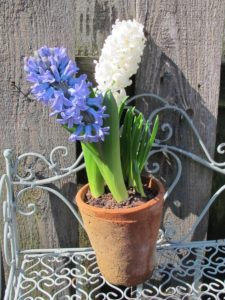
…and in bloom.
Rock Gardens
Here’s a scene (photo, above) where groups of spring-flowering bulbs would feel right at home. Maybe they’re already there and we just missed the show. Emerging perennials hide the ripening foliage of the bulbs, and the distant treeline makes an excellent backdrop.
Don’t Overlook the Little Ones
Green Spring Gardens is a beautiful public garden in Annandale, Virginia, just outside Washington, D.C. Delicate and fleeting bulbs grew in rock gardens in front of the main building, in lean, gritty soil. The display transformed weekly as new bulbs came into flower and diminutive perennials rose to greet the warming days.
I haven’t been there in 7 or 8 years, since I last sold plants at their spring sales, and I wonder if the bulb gardens are still there. For those who like little bulbs, the effect was unforgettable, mimicking the rocky scree of an alpine meadow.
Each of the small species of bulbs adds its own special charm to a rock garden, to the base of a tree trunk or a boulder, or even added to a spring-flowering combination pot.
Obviously I enjoy growing spring-flowering bulbs. I hope you will try growing bulbs in your own garden. Finally, be sure to visit public parks and botanical gardens starting in mid winter to catch the earliest flowers. Notice how bulbs are used with trees and shrubs, and how they might add a unique element to your own landscape.
More Bulbs to Consider
Crocus olivieri balansae ‘Orange Monarch’, Scilla mischtschenkoana, Scilla bifolia ‘Rosea’, Iris reticulata ‘Harmony’, Hyacinthus orientalis ‘Delft Blue’, Fritillaria imperialis ‘Crown Imperial’, Fritillaria persica, Leucojum aestivum, Iris Hermodactylus tuberosus, Allium caeruleum, Ipheion ‘Rolf Fiedler’, Oxalis adenophylla, Erythronium pagoda, Anemone blanda, Narcissus bulbocodium…
Headings
Page 1: Time For Spring Flowering Bulbs, On the Subject of Tulips, How Bulbs Work, and First, a few words on summer- and fall-blooming bulbs (Elephant Ears, Caladium, Amaryllis, Colchicum Autumnale, Fall Crocus)
Page 2: Color Effects, Formal and Informal, Naturalizing in Lawns, Naturalizing in Meadows, If You’re New To Spring-Flowering Bulbs, When Planting Drifts of Bulbs (Microclimates and Timing, Laying Out the Beds), and Aftercare
Page 3: Galanthus, Crocus (Snow Crocus, Giant Dutch Crocus), Eranthis, Muscari, and Puschkinia
Page 4: Hyacinthoides, Tulipa (Tulips In Zones 7 and South, Species Tulips), Hyacinthus, Narcissus (Buying Daffodil Bulbs, Linnaeus, the RHS, and the ADS, Planting Daffodils, Fragrant Daffodils), and Allium
Page 5: Maintenance, Tricks to Hide Maturing Foliage, Stinzenplanten, Forcing Spring-Flowering Bulbs, Rock Gardens, and Don’t Overlook the Little Ones
